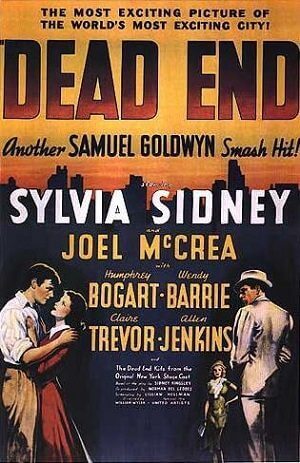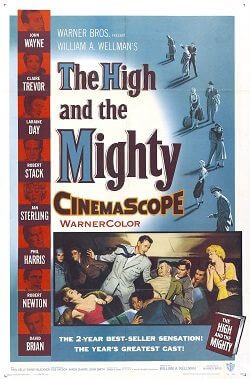Claire Trevor’s heyday was in the 1940s and 1950s. She was a consummate actress who never gave a bad performance. She has a gold Academy Award® statuette for her stunning and poignant performance in Humphrey Bogart’s 1948 hit Key Largo and an Oscar® nomination for her role in the exciting John Wayne aviation hit of 1954, The High and the Mighty. Earlier in her career she was honored with her first Oscar® nomination for Best Supporting Actress in 1937’s Dead End.
She was a beautiful woman, sometimes blonde, sometimes a brunette depending on the role she was playing. But she wasn’t beautiful in the way Golden Age beauties Lana Turner or Ava Gardner were. She had her own style, tough and vulnerable at the same time. That’s what made her so appealing to both men and women. Men wanted to ravage and tame her and women wanted to be like her.
Claire Trevor was born Claire Wemlinger on March 8, 1909 in Bensonhurst, Brooklyn, New York. Her father, a merchant on Fifth Avenue, moved the family to the more prestigious Larchmont in Westchester County where Claire grew up. She always had leaned toward the artistic community and, after graduating from high school, attended Columbia University and studied art. She left there and sauntered over to the American Academy of Dramatic Arts. They taught her about acting, which led to “paying her dues” acting in small repertory theatres on Long Island and far away St. Louis and Michigan. She graduated to the big time when she appeared in the hit Broadway play “Whistling in the Dark.” Unfortunately, her next appearance was in the flopperoo The Party’s Over. It was.
Luckily for Claire, a talent scout from Fox Films (not yet 20th Century Fox) signed her to an iron-clad five-year contract in 1933 to appear in whatever they wanted her to do, good or bad. It turned out most of the pictures were cheap “B” programmers, Westerns and melodramas. In those days, contract players were mostly slaves — glamorous slaves, at that — and Ms. Trevor was treated no differently. She worked day and night on an exhaustive schedule to crank out 14 quickies during the next few years. It was difficult but it served as a sort of match-book cover school of acting.
During the 1930s she appeared as leading lady in more than 30 potboilers, always lending the film a little something extra it didn’t have without her. By 1937 she was well-established in Hollywood and the major directors began to notice her.
Producer Samuel Goldwyn bought the screen rights to the hit Broadway play Dead End by writer Sidney Kingsley in the late 1930s. Set in the slums of New York, it marks the first time the Dead End Kids appeared in a film. Starring was the wonderful actress Sylvia Sidney. Handsome Joel McCrea was the leading man and Humphrey Bogart played Baby Face Martin, the thug who goes wrong. Claire Trevor, at 26, was signed to play Francie, the ex-girlfriend of Baby Face, now a prostitute suffering from the final stages of an STD. It was a wonderful part for Trevor, and director William Wyler guided her to win an Academy Award® nomination as Best Supporting Actress. Dead End catapulted Trevor into the big leagues.
Although Trevor made 68 films in her career, we are highlighting only five of her excellent roles. In 1938 she made four more films. But it was in 1939 when she made what is perhaps the capstone of her movie career. Director John Ford cast her in his film about the American West, Stagecoach. It has been selected by the Library of Congress as “culturally, historically, or aesthetically significant” and as such, was selected for preservation by the National Film Registry.
Stagecoach was nominated for Best Picture, Best Director, Best Art Direction (Alexander Toluboff), Best Cinematography (Bert Glennon), Best Film Editing (Dorothy Spencer, Otho Lovering) and won Oscars® for Thomas Mitchell as Best Supporting Actor and Best Music Scoring for Leo Shuken, John Leipold, W. Franke Harling, and Richard Hageman.
The film had been rejected by every studio in town when John Ford presented it for production. Westerns were not in favor. Ford insisted on using John Wayne in the picture, but he was not an A-list actor and had been in dozens of low-budget oaters in the 1930s that had been mostly flops. Nobody would finance a film starring Wayne. Independent producer Walter Wanger insisted on having Marlene Dietrich and Gary Cooper star. Ford still insisted on John Wayne and compromised on the budget if Claire Trevor got top billing and Wayne would be second. And that is how Ms. Trevor became the star of Stagecoach. She has gone down in the annals of Hollywood history as being the major female actress in one of the greatest Westerns ever made!
The 1940s were top-earning years for Trevor. In addition to all of her films she appeared regularly on popular radio shows with film stars Edward G. Robinson (Double Indemnity) and Don Ameche (Down Argentine Way). By the time she made another of her significant films in 1944, she starred in nine films including Honky Tonk, The Woman of the Town, and The Desperadoes.
Film noir was beginning to gain popularity in the ’40s. RKO Studios bought author Raymond Chandler’s Farewell, My Lovely novel that had been a huge hit in 1940. Director Edward Dmytryk managed to wrestle through the usual convoluted Chandler plot to make one of the best interpretations of the author’s work. Former Warner Bros. crooner Dick Powell (42nd Street) changed career directions to play the hard-boiled private detective Philip Marlowe. To ensure audiences didn’t think the film was a musical because of Powell’s starring role, the studio changed the title to Murder, My Sweet. Claire Trevor was given the difficult task to play two different women—one as Velma Valento, a singer in a lugubrious nightclub, and the other as Helen, (wicked step-mother to Ann) who is married to Ann’s wealthy father whom she intends to take to the cleaners. Ann is cub newspaper reporter Ann Grayle, played by the lovely Anne Shirley. She had made a name for herself as an actress in Anne of Green Gables in 1934 and later as the wife of screenwriter Charles Lederer (His Girl Friday) in 1949. There are a lot of Ann’s involved to make it more confusing.
Murder, My Sweet became one of the top hit pictures of 1944. It is considered one of the best adaptations of Chandler’s work, which contains one of Claire Trevor’s best roles.
After making seven more pictures, this brought Trevor to 1948, a banner year, indeed. She was cast in director John Huston’s Warner Bros. noir film, Key Largo. The stars were Humphrey Bogart as Maj. Frank McCloud, Edward G. Robinson as Johnny Rocco, Lauren Bacall as Nora Temple, Lionel Barrymore as Bacall’s father-in-law James Temple, and Claire Trevor as Gaye Dawn. When a violent tropical storm tosses up strangers to a remote island hotel, several of the men are members of gangster Johnny Rocco’s thugs. Trevor plays an alcoholic, washed up girlfriend of Rocco’s who is a broken-down nightclub singer. Robinson is at his best as the consummate gangster and plays it to the hilt. In the scene which won Trevor her Oscar© as Best Supporting Actress, director Huston would not let her rehearse it and made her sing it cold in one take. The song was “Moanin’ Low,” made popular in 1929 about a woman caught in a relationship with a mean, cruel man. That man was Robinson, and he made her sing it before giving her a drink. She needed the drink and began suffering alcoholic tremors. Trevor began the song and slowly deteriorated throughout the verses until she finally cracks. Trevor was superb in the scene. She showed the gamut of emotions from humiliation, anxiety, fear, and yearning for physical relief at her final breakdown. It is probably Trevor’s best and most poignant performance.
One of the most famous of Trevor’s pictures was an early aviation disaster story. Author Ernest K. Gann was a pilot himself, so he wrote what he knew. The novel was a hit in 1953, and the film was made for Wayne-Fellows Productions for a Warner Bros. release in 1954. Director William A. Wellman shot The High and the Mighty for $1.4 million and the film grossed more than 8 times its cost. When a plane takes off from Honolulu for a flight to San Francisco, John Wayne and Robert Stack are guiding the plane. On board are 17 passengers, all of whom seem to have personal problems to the extreme. Flight Attendant Spalding (starlet Doe Avedon) does her best to take care of their needs. Society Heiress Lydia Rice (Laraine Day) can’t seem to cope with being pampered, aging beauty queen Sally McKee (Jan Sterling) is upset about fading, and spoiled movie actress May Holst (Claire Trevor) has a jaded view of life.
When the plane develops engine trouble over the Pacific past the point of no return, the picture picks up excitement and the cast earns their bloated salaries. Both Sterling and Trevor compete for screen time to see which one is the best. In an unprecedented move never before seen on screen, Sterling actually removes all her make-up to show how horrible she really looks. It’s a scene-stealer. Claire Trevor one-ups her with her jaded view of life and sharp-tongued dialogue. Both actresses were cited numerous times for their performances and both were nominated as Best Supporting Actress in the Oscar® race that year. It was Trevor’s final Academy Award® nomination.
Ms. Trevor lived on and performed on many television shows well into the 1980s. She died on April 8, 2000 at the age of 91.








